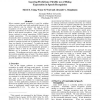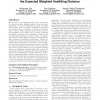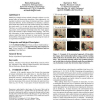129 search results - page 12 / 26 » Why we search: visualizing and predicting user behavior |
IJCAI
1989
13 years 8 months ago
1989
entional user behavior, we need a principled mannerAbstract for relaxing contextual constraints when they are violated.When computer speech recognition is used for problem In order...
WWW
2010
ACM
14 years 2 months ago
2010
ACM
We introduce a new dissimilarity function for ranked lists, the expected weighted Hoeffding distance, that has several advantages over current dissimilarity measures for ranked s...
IUI
1999
ACM
14 years 8 hour ago
1999
ACM
The advent of the Web has brought an unprecedented amount of information together with a large, diverse set of users. Online users are performing a wider variety of tasks than eve...
VL
2010
IEEE
13 years 6 months ago
2010
IEEE
Many machine-learning algorithms learn rules of behavior from individual end users, such as taskoriented desktop organizers and handwriting recognizers. These rules form a “prog...
ICMI
2010
Springer
13 years 5 months ago
2010
Springer
Identifying verbally and non-verbally referred-to objects is an important aspect of human-robot interaction. Most importantly, it is essential to achieve a joint focus of attentio...



